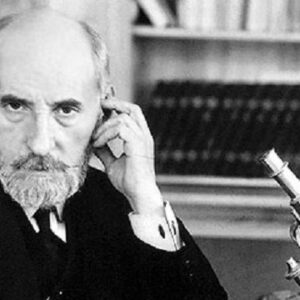Ramón y Cajal was a well-known Spanish pathologist, neuroscientist, and histopathologist. He was a recipient of the Nobel Memorial Prize in Physiology or Medicine. He is widely regarded as the founder of modern neuroscience due to his studies of the brain’s microscopic structure. He was an exquisite painter who had a strong grasp of visual aesthetics and a natural ability to translate the visual onto the paper. His intricate drawings of brain cells have become legendary, and they are still used to educate and train aspiring neurologists. Ramón y Cajal was profoundly influenced by Camillo Golgi’s observations about the nervous system’s structure. While Golgi believed that nerve cells formed a continuous network, Ramón y Cajal’s work established that the nervous system is composed of millions of individual nerve cells. This discovery advanced the fields of cell biology and pathology. Additionally, he was interested in gymnastics and philosophy. Ramón y Cajal was also an accomplished photographer, having captured numerous images of his native land, friends, and relatives. These are on display at Madrid’s Cajal Museum. He was a bundle of contradictions, as he was restless and energetic on the one hand and shy and solitary on the other.
Childhood & Adolescence
Santiago Ramón y Cajal was born in Petilla de Aragón, Northeast Spain, on May 1, 1852. His father was a village surgeon who later worked at the University of Zaragoza as a Professor of Dissection.
To tame his wild nature, he was apprenticed to a shoemaker and a barber.
His father took him to graveyards in the summer of 1868 to collect bones for anatomical study. Sketching bones piqued his interest, and this ability ultimately helped him succeed in his medical career.
Ramón y Cajal attended the University of Zaragoza’s medical school and graduated with a Licentiate in Medicine in 1873.
He became an army doctor in the Spanish army after passing a competitive examination.
He contracted malaria and tuberculosis during a Cuban expedition in 1874-75 and was forced to recuperate at the Panticosa spa town in the Pyrenees.
In 1875, he was appointed assistant at Saragossa’s Faculty of Medicine’s School of Anatomy.
In 1877, he was awarded a Doctor of Medicine degree in Madrid.
Career of Santiago Ramón y Cajal
Ramón y Cajal was appointed Director of the Saragossa Museum in 1979.
In 1883, he was appointed professor of descriptive and general anatomy at Valencia University.
He was presented with a modern Zeiss microscope by the Provincial government of Zaragoza in 1885, during his tenure as Professor at the University of Valencia. This was done in recognition of his efforts during a cholera outbreak.
Ramón y Cajal relocated to Barcelona at the end of 1887, where he was appointed Professor of Histology and Pathological Anatomy.
He was appointed to the same position at the University of Madrid in 1892.
In 1900-1901, he was appointed Director of the Instituto Nacional de Higiene and the Laboratorio de Investigaciones Biológicas, which became the Cajal Institute.
Significant Works of Santiago Ramón y Cajal
The axonal growth cone was Ramón y Cajal’s greatest discovery. He established the contiguous relationship between nerve cells through experiments. This resulted in the “neuron doctrine,” which is now widely regarded as the foundation of modern neuroscience.
Additionally, he identified an interstitial cell in the gastrointestinal tract. This cell acts as a generator and pacemaker, generating slow wave potential and assisting smooth muscle contraction. After Cajal, the cell was dubbed the ‘interstitial cell of Cajal.’
Publications of Santiago Ramón y Cajal
He authored numerous scientific papers in Spanish, French, and German. Among the most notable are ‘Manual of normal histology and micrographic technique’ (1889), ‘Elements of histology, etc.’ (1897), ‘Manual of general pathological anatomy’ (1890), ‘New ideas on the fine anatomy of nerve centers’ (1894), ‘Textbook on the nervous system of man and vertebrates’ (1897-1899), and ‘The retina of vertebrates’ (1899). (1894).
Awards and Accomplishments
In 1906, he and Italian neuroscientist Camillo Golgi shared the Nobel Prize in Physiology or Medicine for their research on the nervous system. During his Nobel lecture, Golgi discussed his belief in “reticular” neural networks, which Cajal, a proponent of individual cell contiguity, refuted.
He also received honorary doctorates in medicine from Cambridge and Würzburg universities, as well as a philosophy honorary doctorate from Clark University.
Juan Lacruz named the asteroid 117413 Ramon y cajal in his honor.
Personal History and Legacies
He married Silvera Faanás Garca in 1879 and remained with her until her death in 1930. They had seven children, two of whom died in infancy.
On October 18, 1934, Ramón y Cajal died in Madrid.
Estimated Net Worth
The estimated net worth of Santiago Ramón y Cajal is unknown.
Trivia
The scientist’s paternal surname was ‘Ramón,’ and his maternal surname was ‘Cajal.’ This is a little-known fact, and the obvious error of simply calling him ‘Cajal’ is frequently repeated. However, it is worth noting that in Spain, the name ‘Cajal’ is preferred because ‘Ramón’ is also a forename.
Ramón y Cajal was an opportunistic and rebellious child. Despite his apparent intelligence, he was transferred from one school to another several times due to his attitude.
At the age of eleven, he was imprisoned for destroying his neighbor’s yard gate with a homemade cannon.


